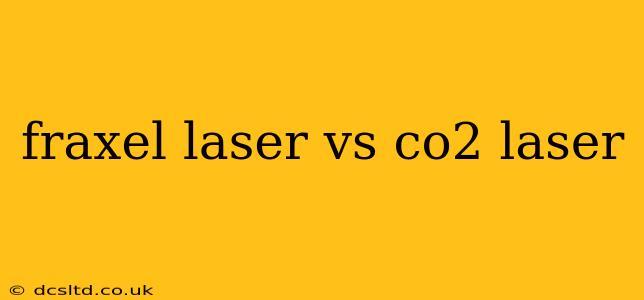Choosing between a Fraxel laser and a CO2 laser for skin rejuvenation can feel overwhelming. Both are powerful tools, but they work differently and are best suited for different skin concerns and patient preferences. This comprehensive guide will explore the key differences, helping you make an informed decision.
What is a Fraxel Laser?
Fraxel lasers use fractional resurfacing technology. This means they target only a fraction of the skin's surface at a time, leaving healthy tissue untouched. This approach minimizes downtime and side effects while still achieving significant results. Fraxel treatments are versatile, addressing various concerns like wrinkles, acne scars, sun damage, age spots, and uneven skin tone. Several types of Fraxel lasers exist, each with its own wavelength and energy settings, tailored to specific skin types and conditions.
Advantages of Fraxel Laser:
- Less downtime: Compared to CO2 lasers, Fraxel treatments generally result in shorter recovery periods.
- Lower risk of complications: The fractional approach minimizes the risk of scarring, hyperpigmentation, and other side effects.
- Suitable for various skin types: Fraxel lasers can be customized to suit different skin tones and sensitivities.
- Gradual improvement: Results often appear gradually over several weeks, leading to a more natural-looking outcome.
What is a CO2 Laser?
CO2 lasers are ablative lasers, meaning they remove the top layer of skin to stimulate collagen production and skin renewal. This aggressive approach leads to more dramatic results but also involves a longer recovery period and a higher risk of complications. CO2 laser treatments are frequently used to treat deep wrinkles, severe acne scarring, and significant sun damage.
Advantages of CO2 Laser:
- More dramatic results: CO2 lasers deliver more visible improvements in a shorter number of sessions.
- Effective for deeper skin concerns: They are better suited for treating severe wrinkles and deep scarring.
Fraxel Laser vs. CO2 Laser: Key Differences Summarized
| Feature | Fraxel Laser | CO2 Laser |
|---|---|---|
| Type | Fractional ablative/non-ablative | Ablative |
| Depth of Treatment | Superficial to deep | Deep |
| Downtime | Minimal to moderate | Significant |
| Recovery Time | Days to weeks | Weeks to months |
| Risk of Complications | Lower | Higher |
| Best for | Mild to moderate skin concerns | Severe skin concerns |
| Cost | Generally less expensive | Generally more expensive |
Which Laser Treatment is Right for Me?
The best laser treatment depends entirely on your individual needs and skin condition. Factors to consider include:
- Severity of skin concerns: Mild wrinkles and superficial scars may respond well to Fraxel, while deep wrinkles and severe scarring might require CO2.
- Skin type and tone: Certain skin types and tones might be more suitable for Fraxel due to its lower risk of complications.
- Downtime tolerance: If you have limited time for recovery, Fraxel is generally preferable.
- Budget: CO2 laser treatments often cost more than Fraxel treatments.
A consultation with a qualified dermatologist or cosmetic surgeon is crucial to determine the most appropriate treatment for your specific situation. They will assess your skin, discuss your goals, and recommend the best approach to achieve optimal results.
What are the side effects of Fraxel and CO2 lasers?
Fraxel: Common side effects include redness, swelling, and mild discomfort, typically resolving within a few days. Some patients may experience temporary crusting or scabbing.
CO2: Side effects are more pronounced and can include significant swelling, redness, blistering, crusting, and scabbing. The recovery period is longer, and the risk of complications such as scarring and changes in skin pigmentation is higher.
How many treatments are needed for Fraxel and CO2 lasers?
The number of treatments needed varies depending on the individual's skin condition and the desired outcome. Both Fraxel and CO2 treatments may require multiple sessions spaced several weeks apart to achieve optimal results. Your doctor will advise on the appropriate treatment plan.
How long do the results of Fraxel and CO2 lasers last?
The longevity of results depends on various factors, including sun exposure, genetics, and aging process. While both treatments can provide long-lasting improvement, ongoing sun protection is essential to maintain the results.
This information is for educational purposes only and is not a substitute for professional medical advice. Always consult with a qualified healthcare provider to determine the best treatment plan for your specific needs.
